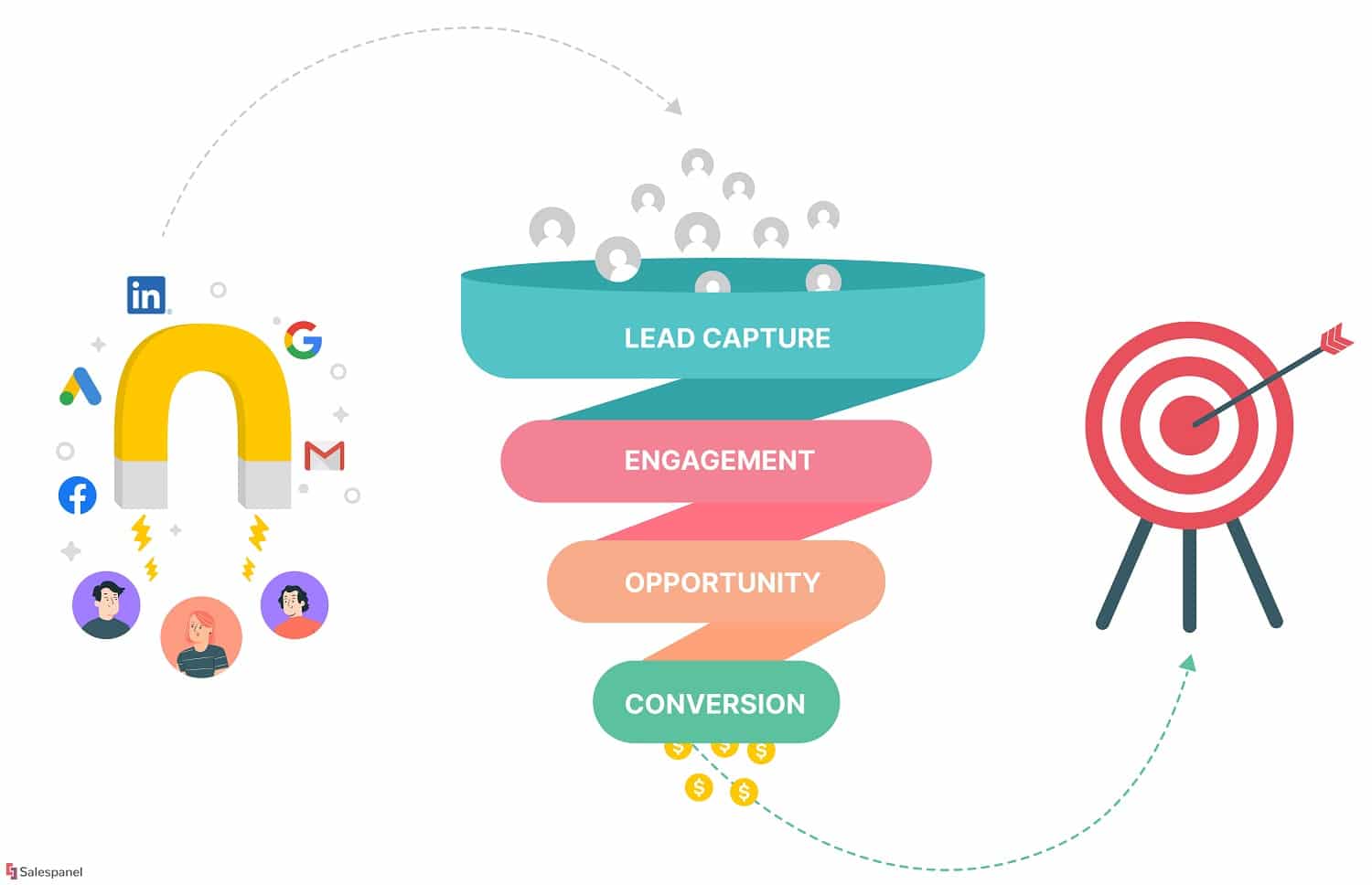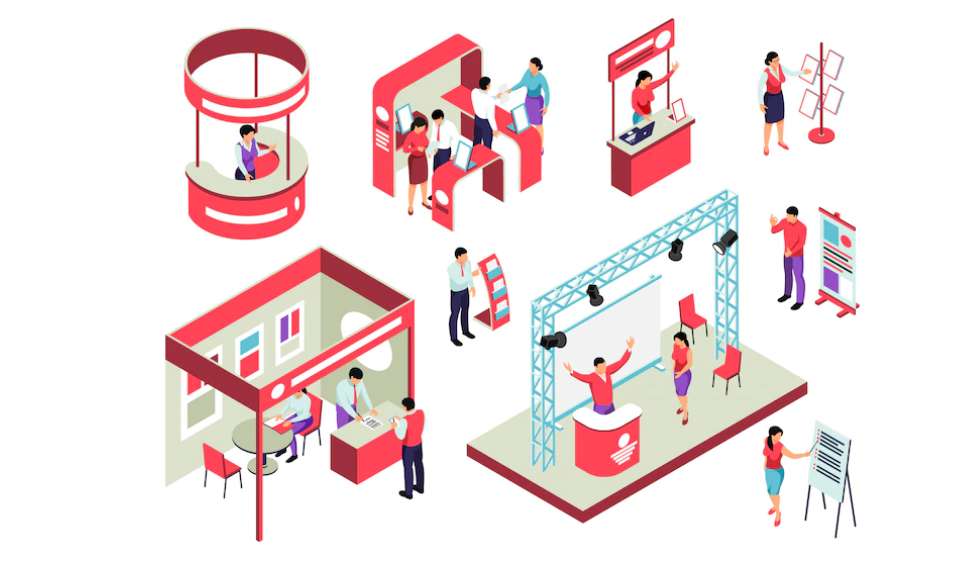
Cold Outreach In B2B Lead Generation: Expectations vs. Reality
October 16, 2023
10 Proven Strategies to Skyrocket Your Inbound Marketing Success
October 16, 2023The Power of Networking and Events
In a world that is increasingly digitized, the power of networking and events cannot be overstated. It’s the secret sauce that adds a personal touch to the otherwise mechanical world of B2B interactions. Networking is not just about trading business cards; it’s about making genuine connections. It’s the art of forging relationships that can open doors and lead to success. When combined with events, it becomes a potent formula for B2B lead generation.
Think about it – every great business deal, partnership, or collaboration often starts with a conversation. And where do those conversations take place? Frequently, they happen at networking events. These events provide a platform for professionals to meet, exchange ideas, and explore potential synergies. In a single room, you might find your next client, business partner, or mentor. The power of a face-to-face conversation should not be underestimated.
Why B2B Lead Generation Matters
B2B lead generation is the lifeblood of any business that aims to grow. In essence, it’s the process of finding potential customers interested in your product or service and nurturing them through the sales funnel. Without a consistent influx of targeted leads, businesses can stagnate, struggle to compete, or worse, wither away. It’s not just a matter of importance; it’s a matter of survival in the corporate jungle.
The key to understanding the significance of B2B lead generation is recognizing that not all leads are created equal. Quality leads are those who have a genuine interest in what your business offers. They are more likely to convert into loyal customers, and this, in turn, leads to profitability. Therefore, the focus of any B2B lead generation strategy should be on attracting these high-quality leads.
What to Expect from This Blog Post
Now that you understand the significance of networking and B2B lead generation let’s delve into what you can expect from this blog post. We’ll take you on a comprehensive journey through the world of B2B lead generation with a particular focus on networking and events. Our aim is to demystify the process and show you that success in this arena is more attainable than you might think.
You can look forward to a detailed exploration of each aspect, from the fundamentals of networking to the intricacies of measuring success. Real-life examples and practical advice will be sprinkled throughout the blog post to help you grasp the concepts effectively. By the end of this journey, you’ll have the insights and knowledge to excel in B2B lead generation.

Understanding B2B Lead Generation
Defining B2B Lead Generation
At its core, B2B lead generation is about finding potential customers, also known as leads, who have expressed an interest in your product or service and guiding them through the sales pipeline. These leads are the lifeblood of your business, the prospects who might eventually become your loyal customers.
Lead generation starts with identifying your target audience – those who are most likely to benefit from what your business offers. It’s not a scattershot approach; it’s precision marketing. Instead of trying to attract everyone, you focus your efforts on those who are more likely to convert into paying customers. This targeted approach saves time and resources, making your lead generation efforts more efficient and cost-effective.
The Importance of Targeted Leads
In the B2B world, not all leads are created equal. Imagine having a list of potential clients who are genuinely interested in what you offer. They’ve expressed a need for your product or service, and they are actively seeking a solution. These are the leads you want, and they’re known as “warm” or “hot” leads.
On the flip side, imagine spending resources on leads who have no interest in your offerings. Not only is this a waste of time and money, but it can also be demoralizing for your sales team. The key to successful B2B lead generation is to focus on attracting high-quality, targeted leads. This is the most efficient and profitable approach.
Challenges in B2B Lead Generation
While B2B lead generation is essential, it’s not without its challenges. The business landscape is highly competitive, and attention spans are shorter than ever. To succeed in B2B lead generation, you need to overcome these challenges:
-
Competition: Your competitors are also vying for the same leads. Standing out in a crowded marketplace can be tough.
-
Changing Landscape: The business environment is constantly evolving. New technologies and strategies emerge, and you need to stay ahead of the curve.
-
Data Privacy: With stringent data protection laws like GDPR, acquiring and using customer data requires a careful approach.
-
Lead Nurturing: Converting leads into customers is a complex process. It requires a strategic approach and effective communication.
-
Measuring Success: To improve your lead generation efforts, you need to track and analyze data effectively. This can be challenging without the right tools and knowledge.
In the following sections, we’ll address each of these challenges and provide strategies and insights to help you navigate the complex world of B2B lead generation.

The Role of Networking in B2B Lead Generation
The Basics of Networking
Networking is often misunderstood as a mere exchange of business cards or a superficial interaction at social events. However, it’s much more profound than that. At its heart, networking is about building relationships and nurturing them for mutual benefit.
Effective networking involves:
-
Building Trust: Trust is the foundation of any successful relationship. It’s crucial in business because people prefer to do business with those they trust.
-
Effective Communication: Being able to communicate your value proposition clearly and concisely is vital.
-
Adding Value: Offering something valuable, whether it’s knowledge, connections, or resources, can set you apart.
-
Consistency: Networking is not about occasional interactions; it’s about maintaining relationships over time.
-
Reciprocity: A healthy network involves giving and receiving help. It’s not a one-way street.
-
Leveraging Connections: Your network isn’t just about the people you know; it’s about the people they know.
By understanding and implementing these principles, you can build a strong network that becomes a valuable asset in your B2B lead generation efforts.
Types of Networking Events
Networking events come in various forms, catering to different niches and industries. To leverage networking effectively, you must understand the types of events and their unique benefits.
-
Industry Conferences: These events bring together professionals in a specific industry. They offer a great platform to meet peers, potential clients, and partners who are already interested in your field.
-
Local Business Meetups: These are smaller, more casual events. They’re excellent for building local connections, whether you’re looking for clients or collaborators.
-
Chamber of Commerce Events: Many cities have chambers of commerce that host events. They are great for building local connections and getting involved in the business community.
-
Trade Shows: These events are highly focused on specific industries or products. If you’re looking for a targeted audience, trade shows are the way to go.
-
Online Networking: In the digital age, networking also happens online. Platforms like LinkedIn have made it easier to connect with professionals worldwide.
Understanding the types of events available can help you choose the right ones for your business. Each type of event has its unique advantages and caters to specific needs. In the next section, we’ll delve into the benefits of face-to-face networking.
Benefits of Face-to-Face Networking
In the digital age, face-to-face networking remains a powerful tool for several reasons:
-
Building Trust: Trust is established more quickly and effectively when you meet someone in person. Body language, eye contact, and a firm handshake can convey trustworthiness.
-
Deeper Connections: In-person meetings often lead to more profound and meaningful conversations. This makes it easier to understand your potential leads and their needs.
-
Immediate Feedback: You can gauge a person’s interest and response in real time. This instant feedback is invaluable in adjusting your approach.
-
Memorability: People remember in-person interactions more than digital ones. If you make a positive impression at an event, you’re more likely to be remembered.
-
Networking in Context: Events provide a context for networking. Everyone is there to connect and explore opportunities, which makes the process smoother.
In essence, while online networking has its place, face-to-face interactions have unique advantages that can significantly impact your B2B lead generation efforts. The challenge lies in making the most of these opportunities, and that’s what we’ll explore in the upcoming sections.

Events: A Gateway to Leads
Different Types of B2B Events
B2B events come in a variety of forms, each offering unique opportunities for lead generation. Understanding these different event types and their respective advantages can help you strategically choose where to invest your time and resources.
-
Trade Shows: These events are industry-specific and bring together a wide range of businesses within a particular niche. Attending trade shows can expose your brand to a highly targeted audience genuinely interested in your offerings.
-
Conferences and Seminars: These events provide a platform for industry thought leaders to share knowledge and insights. By participating or presenting at these events, you position yourself as an expert in your field, attracting leads seeking your expertise.
-
Workshops and Training Sessions: Hosting workshops allows you to educate potential clients about your products or services. By providing value through teaching, you can naturally convert attendees into leads who trust your knowledge and capabilities.
-
Webinars and Virtual Events: In the digital age, virtual events have gained popularity. They enable you to connect with a global audience. Engaging webinars can be a fantastic way to generate leads who are willing to exchange their contact information for valuable insights.
-
Networking Mixers: While these events are primarily focused on networking, they can lead to valuable connections. Networking mixers bring professionals from various industries together, increasing the diversity of potential leads.
The Power of Event Marketing
Events, regardless of their type, offer unique opportunities for marketing your brand and generating leads. The event itself acts as a magnet, attracting individuals genuinely interested in the topic or industry it represents. To harness this magnetism for lead generation, consider the following strategies:
-
Pre-Event Promotion: Building anticipation for your event is essential. Utilize email marketing, social media, and your website to inform your target audience about the event’s details, benefits, and how to register.
-
Engaging Content: Whether you’re presenting at a conference or hosting a webinar, the content you deliver is key. Make sure it’s engaging, relevant, and valuable to your audience.
-
Interactive Elements: Incorporate interactive elements in your event to keep attendees engaged. This might include Q&A sessions, polls, or breakout groups.
-
Follow-up Plan: The real lead generation often happens after the event. Have a plan for following up with attendees. This can include sending them post-event resources, asking for feedback, or offering exclusive deals.
-
Branding Opportunities: Events provide unique branding opportunities. Ensure that your branding, from banners to presentation slides, is cohesive and reinforces your message.
Effective Event Strategies for Lead Generation
Simply attending or hosting an event is not enough; you need a clear strategy to convert event participation into lead generation. Here are some effective event strategies:
-
Leverage Event Technology: Many events now use technology platforms for registration, networking, and content sharing. Utilize these platforms to connect with attendees and gather their contact information.
-
Educational Content: If you’re presenting at an event, focus on delivering educational content that showcases your expertise. Attendees are more likely to consider you a valuable resource.
-
Engage Attendees: During the event, engage with attendees. Answer questions, participate in discussions, and be an active part of the event’s community.
-
Offer Incentives: Consider offering incentives for attendees to share their contact information. This could be exclusive content, discounts, or access to premium resources.
-
Post-Event Nurturing: The follow-up is vital. Send personalized messages to attendees, thanking them for their participation and offering further engagement opportunities.
-
Measure and Analyze: After the event, analyze the data to measure its success. Look at metrics like the number of leads generated, conversion rates, and return on investment.
By implementing these strategies, you can turn events into lead generation powerhouses. Events, whether in-person or virtual, offer a unique platform to connect with potential leads in a targeted and engaging manner.

Building Relationships in B2B Lead Generation
The Importance of Building Trust
In B2B lead generation, trust is the currency of business. Trust is what separates you from the competition and forms the foundation of lasting relationships. Building trust involves several key principles:
-
Consistency: Consistently delivering on your promises and commitments is fundamental to building trust. This includes meeting deadlines, delivering quality products or services, and being reliable.
-
Transparency: Open and honest communication is a cornerstone of trust. Concealing information or misrepresenting your offerings can erode trust quickly.
-
Understanding Needs: To build trust, you must understand your lead’s needs and provide solutions tailored to those needs. This requires active listening and a genuine interest in solving their problems.
-
Responsive Communication: Timely responses to inquiries and concerns demonstrate that you value your lead’s time and priorities. Responsiveness builds trust in your professionalism.
-
Effective Problem-Solving: When issues arise, resolving them efficiently and to the satisfaction of your lead is a powerful trust-building opportunity.
-
Adding Value: Providing valuable information, resources, or assistance beyond what is expected can establish you as a trusted source of knowledge and support.
Trust is not something that can be achieved overnight. It’s a relationship-building process that takes time, consistency, and effort. But it’s a process worth investing in because trusted leads are more likely to convert and become loyal customers.
Utilizing Social Media for Relationship Building
In the digital age, social media plays a significant role in building and nurturing relationships. Whether it’s LinkedIn, Twitter, Facebook, or industry-specific platforms, social media can be a powerful tool for connecting with leads. Here’s how to make the most of it:
-
Optimize Your Profiles: Ensure your social media profiles are professional, complete, and reflect your brand’s identity.
-
Engage with Content: Share, comment on, and like relevant content to demonstrate your industry expertise and engage with your audience.
-
Join Groups and Communities: Participate in groups and communities related to your industry. These platforms can be excellent for networking and building relationships.
-
Direct Messaging: Use direct messaging to initiate conversations with potential leads. Keep these initial messages professional and value-focused.
-
Consistent Posting: Regularly share your own content, providing valuable insights and solutions to common industry problems.
-
Leverage Analytics: Most social media platforms offer analytics to track the performance of your posts and interactions. Use this data to refine your strategy.
Social media is not just about the quantity of connections but the quality of relationships you build. Your goal is to connect with leads genuinely interested in your industry or niche, as these are the connections most likely to convert.
Turning Connections into Leads
Making connections, whether through networking events or social media, is only the first step. The ultimate goal is to turn these connections into leads. Here are some strategies to facilitate this transition:
-
Segment Your Connections: Not all connections are at the same stage of readiness to become leads. Segment your connections into different categories based on their level of interest and engagement.
-
Personalize Your Approach: When reaching out to connections, personalize your messages. Refer to specific discussions or content that piqued their interest.
-
Offer Value: Before asking for anything, provide value. Share useful resources or insights that are directly relevant to your connections’ needs.
-
Ask for Permission: When you believe a connection is ready to become a lead, ask for permission to continue the conversation. Ensure you respect their preferences regarding communication.
-
Nurture the Relationship: Lead nurturing is an ongoing process. Keep the conversation going and continue to provide value.
By following these strategies, you can smoothly transition from making connections to nurturing them into valuable leads. This process hinges on a balance of engagement, personalization, and the consistent delivery of value.

Measuring Success in B2B Lead Generation
Key Performance Indicators (KPIs)
In the world of B2B lead generation, measurement is paramount. To assess the effectiveness of your efforts, you need key performance indicators (KPIs) that serve as metrics of success. These KPIs help you track, analyze, and adjust your lead generation strategies. Here are some essential KPIs to consider:
-
Conversion Rate: The percentage of leads who take a desired action, such as making a purchase or filling out a contact form.
-
Lead Quality: Assess the quality of leads by evaluating their fit with your ideal customer profile, their engagement level, and their likelihood to convert.
-
Cost per Lead (CPL): Calculate how much it costs to generate one lead. This metric helps you understand the efficiency of your lead generation efforts.
-
Return on Investment (ROI): Measure the return you get on your lead generation investment. It’s essential to ensure that the revenue generated from leads exceeds the cost of acquisition.
-
Lead Velocity Rate: This metric measures the growth rate of your leads. It helps you assess the pace at which your lead generation efforts are expanding.
-
Conversion Time: How long does it take for a lead to move through your sales funnel and convert into a customer? A shorter conversion time indicates more efficient lead nurturing.
-
Churn Rate: Evaluate the rate at which leads drop out of the sales funnel. A high churn rate indicates potential issues in your lead nurturing process.
-
Email Open Rate and Click-Through Rate: If email marketing is part of your strategy, monitor open rates and click-through rates. These metrics reflect the effectiveness of your email campaigns.
-
Social Media Engagement: If you’re using social media for lead generation, track engagement metrics like likes, shares, and comments.
-
Web Traffic and Landing Page Conversion Rates: Monitor the number of visitors to your website and the conversion rates on landing pages. These numbers reflect the effectiveness of your online presence.
Tools for Tracking and Analyzing Leads
Effective tracking and analysis are essential to understanding the success of your lead generation efforts. Luckily, there is a wide range of tools and software available to help you with this task. Here are some popular tools for tracking and analyzing leads:
-
Customer Relationship Management (CRM) Software: CRMs like Salesforce, HubSpot, and Zoho CRM help manage leads, track interactions, and measure conversion rates.
-
Google Analytics: A powerful web analytics tool that provides insights into website traffic, user behavior, and conversions.
-
Marketing Automation Software: Tools like Marketo, Pardot, and Mailchimp offer automated lead nurturing and reporting features.
-
Lead Scoring Software: Platforms like LeadSquared and Act-On provide lead scoring capabilities to evaluate the quality of leads.
-
Social Media Analytics Tools: These tools, including Sprout Social and Hootsuite, offer in-depth analytics for social media campaigns.
-
Email Marketing Platforms: Popular email marketing platforms such as Mailchimp and Constant Contact offer detailed reporting on email campaigns.
-
Webinar and Virtual Event Platforms: If you use webinars or virtual events for lead generation, the associated platforms typically provide analytics on attendance and engagement.
-
A/B Testing Tools: Tools like Optimizely and Google Optimize enable you to test different elements of your lead generation campaigns to optimize results.
Optimizing Your Lead Generation Strategy
Optimization is an ongoing process in the world of B2B lead generation. Once you’ve gathered data through the KPIs and analyzed it with the right tools, it’s time to refine your strategy. Here are some steps to optimize your lead generation efforts:
-
Data-Driven Decisions: Use the data you’ve collected to make informed decisions. Identify which lead sources are the most effective and allocate more resources to them.
-
Lead Scoring: Implement lead scoring based on the data you’ve collected. This ensures that your sales team prioritizes high-quality leads.
-
Personalization: Leverage data to create highly personalized lead nurturing campaigns. Tailor your communications to the needs and interests of individual leads.
-
A/B Testing: Continuously test different elements of your lead generation campaigns, including email subject lines, call-to-action buttons, and landing page designs.
-
Content Strategy: Refine your content strategy based on the types of content that resonate most with your leads.
-
Automation: Use marketing automation tools to streamline lead nurturing processes and ensure timely follow-ups.
-
Feedback Loops: Encourage feedback from your sales team regarding the quality of leads. This information can help fine-tune your lead generation efforts.
-
Regular Reporting: Set a schedule for regular reporting and analysis. This ensures that your strategy remains adaptable and data-driven.
By consistently optimizing your lead generation strategy, you can fine-tune your efforts, improve ROI, and keep pace with changes in the market and technology.
Conclusion
Recap of Key Points
In this extensive blog post, we’ve explored the world of B2B lead generation with a particular focus on the underestimated power of networking and events. Let’s recap some of the key points:
-
Networking and events: These are not just traditional practices but a dynamic duo for B2B lead generation. They offer the opportunity to build genuine relationships with potential leads.
-
Targeted leads: The quality of your leads matters more than the quantity. Focusing on high-quality, targeted leads improves your conversion rates and ROI.
-
Challenges: B2B lead generation isn’t without its challenges. Competition, evolving market conditions, and data privacy concerns require a strategic approach.
-
Face-to-face networking: In the digital age, face-to-face interactions at events remain a powerful trust-building tool.
-
Event marketing: Events, when leveraged effectively, can be magnets for generating leads. Pre-event promotion, engaging content, and post-event follow-up are vital.
-
Building trust: Trust is the foundation of B2B relationships. Consistency, transparency, and problem-solving are key components.
-
Social media: Utilize social media platforms to build and nurture relationships with potential leads. Engage, personalize, and offer value.
-
Measuring success: KPIs, lead tracking tools, and data analysis are essential for evaluating your lead generation efforts.
-
Optimization: Ongoing refinement based on data and feedback ensures that your lead generation strategy remains effective.
Unlocking the Potential of Networking and Events in B2B Lead Generation
In conclusion, networking and events are the hidden gems of B2B lead generation. They provide opportunities to connect, build trust, and ultimately convert connections into leads. By understanding the challenges, measuring success, and optimizing your strategy, you can unlock the full potential of these often underestimated tools.
Final Thoughts
B2B lead generation is a multifaceted journey that combines strategy, relationship building, and measurement. Success in this arena is not elusive; it’s a matter of knowledge, adaptability, and the willingness to embrace the power of human connection.
So, as you embark on your B2B lead generation endeavors, remember that it’s easier to succeed with networking and events than you might think. The potential is vast, and the simplicity is hidden in the details. By putting the knowledge gained here into action, you can unlock the full potential of networking and events in your B2B lead generation strategy.


